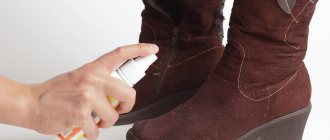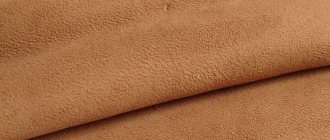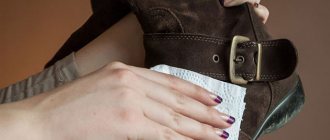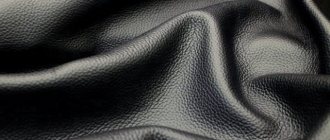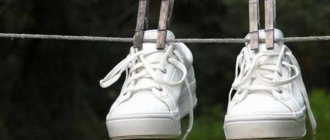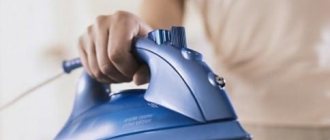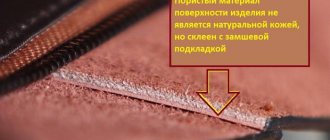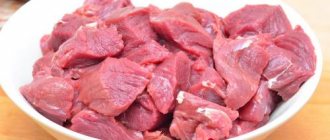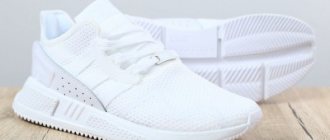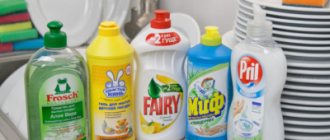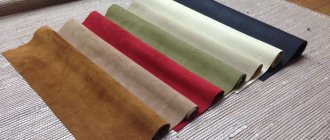Suede
- soft, velvety leather produced by fat and formaldehyde-fat tanning from the skins of any not very large animals.
Artificial suede is produced, which is used for the same purposes as natural one, but is inferior to the latter in some properties.
Suede is also called cotton and silk fabrics that have a pile on the front side that goes on outerwear.
Etymology
According to Vasmer's dictionary, the Russian word “suede” is derived from the Polish zamsz
, which through lower German.
semesch
comes from French.
chamois
(“chamois”). From the name of the same animal comes the designation for suede in other European languages:
- France: suède
,
chamois
,
daim
. - English: suede
,
chamois leather
,
chamoisleather
,
chamois
,
chammy
,
wash-leather
,
oil-leather
. - Germany - Sämischleder
,
Sämischgares Leder
,
Veloursleder
,
Hunting-Leder
. - Poland - zamsz
(from German
Sämischleder
) - suede;
ircha
(Latin
hircus
- goat) - rubbing suede made from the skin of sheep and other animals (also artificial);
but the similar giemza
(from German
Gämse
- chamois), otherwise also
zamsz
or
szewro
(French
chamois
- chamois,
Chèvre
- goat) is not suede, but chrome-tanned goat skin.
In France, suede itself is called “Swedish gloves” (French gants de Suède
), where another popular word form comes from (English
suede
). In many languages, there are synonyms with a broader meaning, denoting both suede and velor[1].
Story
Although treating leather with oil, including fish oil, has been used since ancient times, special glove leather was prepared using the “suede” method ( chamoisage)
,
chamoiserie
,
chamoising
,
Fettgerberei
) began to be produced sometime before 1709 near
Biarritz
in southwestern France. Where it was discovered that the prepared skin of any goat-like animal, including chamois, treated with cod oil, acquires a special hygroscopic property.
Suede technology came to Russia through Poland, where the development of suede production ( zamszownictwa
) existed in the XV-XVI centuries.
and were called soft leather industries ( białoskórnictwa
).
They were most developed in the cities of Gdańsk, Krakow and Lwów ( zamszownicy ormiańscy
).
It is known that in Novgorod the production of suede was carried out by special tanners - “ireshniks” (from “irkha” - suede [2]). In the Arkhangelsk province they called her “vezh” (from vezh
or cleanse the skin) and “mezdryanka” (from
fleshing
).[3]
Dressing and properties
It is distinguished by its thinness, softness, ductility and velvety quality on both surfaces (suede made from the finest raw materials can retain the front layer). It is waterproof and can withstand being in water, almost without losing quality, even after washing in soapy water.
In the production of suede, the prepared raw materials are subjected to a special process - sueding, that is, impregnation with certain types of “active” (unsaturated) fats, which have a high proportion of unsaturated fatty acids - fats of fish (mainly cod) and some marine mammals (seals, whales) (blubber). As well as hoof oil, bone fat, linseed oil and a number of other fats of animal and vegetable origin. Fat oxidation occurs inside the skin and at the same time a stable chemical bond is created with the collagen fibers of the skin. Suede tanning is also used in the production of furs, since the water-repellent properties of suede are useful for the dyeing process, with the necessary immersion in solutions.
In another method of dressing, formaldehyde treatment is first used, and then suede.
For a more complete fatliquoring process, special machines are used - impact crushers.
.
Features of suede
Advantages of natural suede:
- elegance: perhaps no one will argue that suede shoes look just great. No other material can compare with it in style and beauty;
- heat transfer: suede is indispensable for the cold season; in combination with fur, suede produces the warmest winter boots and boots;
- breathability: the “breathing” properties of suede are a salvation for tired feet;
- softness and lightness: exceptionally grateful material that easily adapts to any shape of the foot.
Disadvantages of natural suede:
- high cost: the price of hand-made suede is sometimes higher than that of similar smooth leather;
- poor resistance to dust and dirt;
- difficulty in care.
Among the disadvantages of natural suede, the difficulty in caring for such material is the most significant argument. However, the comfort and external beauty of this noble and elegant material will always win in the eternal debate between pros and cons.
Suede shoes
Application
Suede is used in the manufacture of clothing, shoes, and haberdashery goods. Due to its high softness and good insulating properties, it is used to make gloves. Nowadays, suede is often used to make traditional clothing instead of rawhide ( deerskin
,
rovduga
).
High softness, resistance to washing, high temperatures, alkali and anti-allergic quality are important for the use of suede in orthopedics.
In technology, suede is used, for example, when grinding lenses, as well as for wiping optical and other surfaces. Sometimes used in fuel filters. In the past, suede was also used to clean mercury.
The difference between natural suede and artificial suede
Suede is a popular material used not only for the manufacture of clothing, shoes and accessories, but also for furniture upholstery and other types of decor. In stores you can find products made from both natural and artificial suede. Natural suede is more durable, flexible and wear-resistant. As you know, this type of suede has a velvety and stretchy surface on both sides of the fabric. Artificial suede is a fabric that imitates its natural prototype. Visually they are practically no different. Good artificial suede, impregnated with special protective solutions, also withstands abrasion, repels dirt and practically does not fade.
It is quite easy to distinguish natural material from artificial material. You need to stroke the pile with your hand, and if it changes its slope, shade and texture, then it is natural suede. Artificial fabric very quickly takes on its original appearance. In addition, natural suede immediately shows various defects: scratches, pores and creases. The artificial product usually remains smooth and flawless in appearance. Typically, manufacturers attach a small piece of linen to products made from natural suede, which is a guarantee of quality and naturalness.
Natural suede has a leather smell, while artificial suede has a synthetic smell. If you drop a little water on the surface of the material, natural suede will absorb it immediately, leaving behind only a small wet spot. The artificial material will hold water on the surface for some time.
Notes
- In the West, “velor” is a broad term for leather (and other materials) that has a velvety or rough surface. Leathers include suede, split leather, and velor. There are one-sided and two-sided velor.
- Compare: with Polish ircha
(from Latin
hircus
- goat) - rubbing suede made from the skin of sheep and other animals. Also artificial. - The ancient names “irha”, “vezh”, “mezdryanka” may refer to the so-called “rawhide suede”. This question requires clarification.
Excerpt characterizing Suede
Prince Pyotr Mikhailovich Volkonsky held the position of chief of staff of the sovereign. Volkonsky left the office and, bringing cards into the living room and laying them out on the table, conveyed the questions on which he wanted to hear the opinions of the assembled gentlemen. The fact was that during the night news was received (later turned out to be false) about the movement of the French around the Drissa camp. General Armfeld began to speak first, unexpectedly, in order to avoid the difficulty that had arisen, proposing a completely new, inexplicable position away from the St. Petersburg and Moscow roads, on which, in his opinion, the army should have united and await the enemy. It was clear that this plan had been drawn up by Armfeld long ago and that he now presented it not so much with the aim of answering the proposed questions, which this plan did not answer, but with the aim of taking advantage of the opportunity to express it. This was one of the millions of assumptions that could be made, just as well as others, without having any idea of what character the war would take. Some disputed his opinion, some defended it. The young Colonel Toll, more ardently than others, disputed the opinion of the Swedish general and during the argument took out a covered notebook from his side pocket, which he asked permission to read. In a lengthy note, Toll proposed a different campaign plan, completely contrary to both Armfeld’s plan and Pfuel’s plan. Paulucci, objecting to Tol, proposed a plan for moving forward and attacking, which alone, according to him, could lead us out of the unknown and the trap, as he called the Dris camp, in which we were located. Pfuhl and his translator Wolzogen (his bridge in court relations) remained silent during these disputes. Pfuhl only snorted contemptuously and turned away, showing that he would never stoop to object to the nonsense that he was now hearing. But when Prince Volkonsky, who led the debate, called him to express his opinion, he only said: “Why ask me?” General Armfeld proposed an excellent position with an open rear. Or attack von diesem italienischen Herrn, sehr schon! [this Italian gentleman, very good! (German)] Or retreat. Auch gut. [Also good (German)] Why ask me? - he said. – After all, you yourself know everything better than me. - But when Volkonsky, frowning, said that he was asking his opinion on behalf of the sovereign, Pfuel stood up and, suddenly animated, began to say: “They ruined everything, confused everything, everyone wanted to know better than me, and now they came to me: how to fix it.” ? Nothing to fix. Everything must be carried out exactly according to the principles I have laid out,” he said, banging his bony fingers on the table. – What is the difficulty? Nonsense, Kinder spiel. [children's toys (German)] - He went up to the map and began to speak quickly, pointing his dry finger at the map and proving that no accident could change the expediency of the Dris camp, that everything was foreseen and that if the enemy really goes around, then the enemy must inevitably be destroyed. Paulucci, who did not know German, began asking him in French. Wolzogen came to the aid of his principal, who spoke little French, and began to translate his words, barely keeping up with Pfuel, who quickly proved that everything, everything, not only what happened, but everything that could happen, was all foreseen in his plan, and that if there were now difficulties, then the whole fault was only in the fact that everything was not executed exactly. He laughed ironically incessantly, argued, and finally contemptuously gave up proving, just as a mathematician gives up verifying in various ways the correctness of a problem that has once been proven. Wolzogen replaced him, continuing to express his thoughts in French and occasionally saying to Pfuel: “Nicht wahr, Exellenz?” [Isn't that true, Your Excellency? (German) ] Pfuhl, like a heated man in battle hitting his own, angrily shouted at Wolzogen: - Nun ja, was soll denn da noch expliziert werden? [Well, yes, what else is there to interpret? (German)] - Paulucci and Michaud attacked Wolzogen in French in two voices. Armfeld addressed Pfuel in German. Tol explained it in Russian to Prince Volkonsky. Prince Andrei silently listened and observed. Of all these persons, the embittered, decisive and stupidly self-confident Pfuel most excited the participation of Prince Andrei. He alone, of all the people present here, obviously did not want anything for himself, did not harbor enmity towards anyone, but wanted only one thing - to put into action the plan drawn up according to the theory he had developed over years of work. He was funny, unpleasant in his irony, but at the same time he inspired involuntary respect with his boundless devotion to the idea. In addition, in all the speeches of all the speakers, with the exception of Pfuel, there was one common feature that was not present at the military council in 1805 - it was now, although hidden, a panicky fear of the genius of Napoleon, a fear that was expressed in everyone objection. They assumed everything was possible for Napoleon, waited for him from all sides, and with his terrible name they destroyed each other’s assumptions. Only Pfuel, it seemed, considered him, Napoleon, to be the same barbarian as all the opponents of his theory. But, in addition to a feeling of respect, Pful instilled in Prince Andrei a feeling of pity. From the tone with which the courtiers treated him, from what Paulucci allowed himself to say to the emperor, but most importantly from the somewhat desperate expression of Pfuel himself, it was clear that others knew and he himself felt that his fall was close. And, despite his self-confidence and German grumpy irony, he was pathetic with his smoothed hair at the temples and tassels sticking out at the back of his head. Apparently, although he hid it under the guise of irritation and contempt, he was in despair because now the only opportunity to test it through vast experience and prove to the whole world the correctness of his theory eluded him.
Simple ways to distinguish natural suede from a substitute
Each of us wants to buy something made from natural material, but this does not always work out. A rich assortment makes it difficult to concentrate, and ignorance of how to distinguish natural suede from artificial one pushes you to make the wrong choice. Distinctive properties are easy to spot:
Price
Natural suede item has a high cost. But a large number of zeros in the price tag is not a guarantee that the product will be of appropriate quality.
Smell
A valuable tip is to smell the products while purchasing . A natural item has a natural smell, and the substitute smells like synthetics.
To the touch
You need to run your hand over the pile; if it changes position and becomes a little lighter or darker than the main shade, then the product is made of genuine leather. Also, natural suede is pleasant to the touch, velvety and soft.
Sewing method
When purchasing a jacket, coat, or shoes, you should pay attention to their edges. They do not bend during sewing, but when using a substitute, they turn up.
Structure
When examining a product made of genuine leather, you can see pores and minor scratches. If there are no minor defects, then you have a fake. Don't be afraid to wrinkle the fabric.
If the item is made of synthetics, then a fold will appear on its surface. Natural fabric instantly returns to its original appearance.
Markings on leather products
Label with a piece of material
Conscientious manufacturers offer users to verify that the product is made of natural suede by attaching a small piece of leather to the label.
Markings on shoes and other products:
Checking with a drop of water
When purchasing a suede item, you need to check its quality with a drop of water. If the material is obtained from animal skin, it will instantly absorb water. The substitute will prevent a droplet from penetrating into the fabric for several seconds.
